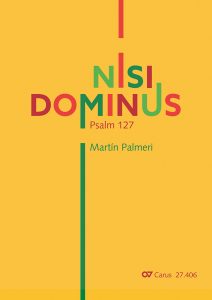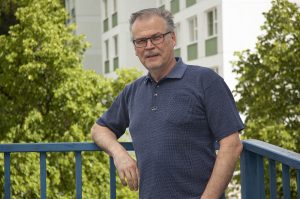Reviewed by Reijo Kekkonen, singer and publisher, Helsinki, Finland
Argentina and Uruguay are renowned as the homelands of tango. People in many countries around the world dance tango, but while the tempo and the interpretation may vary, the love and passion in the music are common to all. For instance, in Finland there is an annual tango festival with a singing competition to elect the Tango-Queen and Tango-King of the year.
Argentinian composer Martín Palmeri made his breakthrough with his Misa a Buenos Aires (1996), which is also known as Misatango. His Misa a Buenos Aires created a whole new genre: nueva tango. It combines the Roman Catholic Mass with tango music. His newest work in the same style was commissioned by the German music publisher Carus-Verlag for their 50th anniversary in 2022. It is written to the text of Psalm 127, Nisi Dominus. It was premiered in June 2022 in Nürnberg at the Musikfest ION by Vokalensemble St. Lorenz and ensemble KONTRASTE with Matthias Ank conducting.
 The Nisi Dominus, like its predecessors, is written for a choir and a typical tango orchestra. In this work, as in Misatango, there is also a soprano soloist. For a performance, it is important to know that the special tango effects are performed by the orchestra, and as the composer himself says, the choir should not make any extra efforts to “sound like tango”. These effects, played especially with piano, bandoneon and double bass, include the so-called arrastres (drags), syncopations, marcati etc. The orchestral parts also include a part for accordion, which may replace bandoneon if needed. However, bandoneon as a “tango instrument” is so emblematic that one could say it is not replaceable. As for the string parts, the composer writes that it is also possible to use a string quintet, in which case the upper parts of the divisi should be prioritised.
The Nisi Dominus, like its predecessors, is written for a choir and a typical tango orchestra. In this work, as in Misatango, there is also a soprano soloist. For a performance, it is important to know that the special tango effects are performed by the orchestra, and as the composer himself says, the choir should not make any extra efforts to “sound like tango”. These effects, played especially with piano, bandoneon and double bass, include the so-called arrastres (drags), syncopations, marcati etc. The orchestral parts also include a part for accordion, which may replace bandoneon if needed. However, bandoneon as a “tango instrument” is so emblematic that one could say it is not replaceable. As for the string parts, the composer writes that it is also possible to use a string quintet, in which case the upper parts of the divisi should be prioritised.
The tempo markings are also interesting. The composer has written metronome markings in the score, but according to him they are the maximum: the tempi may be slower, but they should never be faster. That really is an important thing to know as in many countries tango is performed in quite rapid tempo. In slower tempo you have more space for the passion and love.
The score is published by its commissioner, Carus-Verlag. The cover is bright yellow with colourful letters, which somehow reminds me of La Boca in Buenos Aires. The text of the work is in Latin, and it runs to about 18 minutes. As for its level of difficulty, the publisher classifies Nisi Dominus as a 3 on its scale of 1-5, so it is easily approachable for many choirs. The composition is in three movements, performed attacca. The chorus feels the benefit of classical composing techniques familiar to choirs, who are especially accustomed to singing church music of the romantic era. The role of the orchestra is, as mentioned above, to take care of the tango.
The ambitus of the choir parts is from G of the basses to G2 of the sopranos. The soprano solo goes up to A2. The texture stays mainly on the stave for each part. The intervals are not complicated: there are a few tritones, but if you have sung Bach they are not too difficult to learn. The bass part is presumably written for baritone voices. I feel the absence of any real bass effects, which might have gone well with, for example, the piano and double bass parts, or an a cappella passage with sensitive “tango feeling”.
The balancing of the choir with the orchestra works fine. Of course, if you are performing the work with only a string quintet and not with a string orchestra, you may have to work harder to achieve balance and bring out the sensitivity of the singers. Principally the scoring is professional and not only colla parte.
The full score and vocal score are available for sale at Carus-Verlag and well-equipped music stores. The orchestral materials are available from the publisher for hire only.
 Reijo Kekkonen (*1961) has been working as a director of publishing at Sulasol music publishers since 1988. He graduated from the Sibelius Academy in 1991 with a Master of Music (music education, violin, singing, piano, oboe), with special studies in composition (Vladimir Agopov, Tapani Länsiö) and studies in choral conducting (Matti Hyökki, Erkki Pullinen). He has played with various orchestras and bands and has also worked as a professional singer (2nd bass) in, for example, the Finnish Radio Chamber Choir, Sibelius Academy Vocal Ensemble and Cetus Noster. Kekkonen has adjudicated choral competitions, composition competitions and arrangement competitions worldwide. He has held several positions of trust, both in Finland and elsewhere, at organisations, festivals and competitions. reijo.kekkonen@sulasol.fi
Reijo Kekkonen (*1961) has been working as a director of publishing at Sulasol music publishers since 1988. He graduated from the Sibelius Academy in 1991 with a Master of Music (music education, violin, singing, piano, oboe), with special studies in composition (Vladimir Agopov, Tapani Länsiö) and studies in choral conducting (Matti Hyökki, Erkki Pullinen). He has played with various orchestras and bands and has also worked as a professional singer (2nd bass) in, for example, the Finnish Radio Chamber Choir, Sibelius Academy Vocal Ensemble and Cetus Noster. Kekkonen has adjudicated choral competitions, composition competitions and arrangement competitions worldwide. He has held several positions of trust, both in Finland and elsewhere, at organisations, festivals and competitions. reijo.kekkonen@sulasol.fi
Edited by Karen Bradberry, Australia
